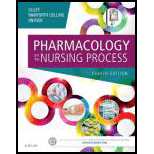
To discuss:
The physiologic influence of various pathologies, such as peptic ulcer disease, gastritis, spastic colon, and gastroesophageal reflux disease, and hyperacidity states, on the health of patients and their gastrointestinal tracts.
Concept introduction:
Excessive production of hydrochloric acid in parietal cells of the stomach that leads to hyperacidity. If this condition is untreated, it could cause esophageal damage, ulcer disease, acid reflux, and esophageal cancer.
Explanation of Solution
Peptic ulcer disease: It is a chronic duodenal ulcer that is characterized by loss of tissue in the lining of the esophagus, duodenum, and stomach. The stomach secretes mucus, bicarbonate, and prostaglandins to protect the membranes of the stomach. Peptic ulcer results from smoking, medications, and acidic drinks, H.pylori infection, stress, and other factors. Symptoms include pain after taking 1 to 2 hours of meals, indigestion, nausea, vomiting, and bleaching. Malignancy risk may occur in severe conditions. Complications of peptic ulcer are a perforation, hemorrhage, narrowing, and obstruction of pyloric part of the stomach.
Gastritis: It is referred to as irritation, inflammation, or erosion of the lining of the stomach by excessive secretion of stomach acid. It may be an acute or chronic disease. Gastritis is caused by the use of excessive alcohol, stress, chronic vomiting, and use of medications such as aspirin, and anti-inflammatory drugs. Helicobacter. Pylori infection also leads to gastritis. Untreated gastritis may cause stomach cancer. Symptoms of gastritis include abdominal bloating, nausea, abdominal pain, indigestion, vomiting, and loss of appetite, tarry, and black stools.
Spastic colon: It is also termed as irritable bowel syndrome (IBS), which is characterized by abdominal pain, abdominal cramping, constipation, bloating, and diarrhea due to increased secretion of acid. Spastic colon increases the contractions of muscles in the large and small intestines. Other symptoms that include fatigue, headache, depression, anxiety, and backache also occur in the spastic colon.
Gastroesophageal reflux disease: It is a condition of pathologic of stomach acidity. It leads to symptoms such as heartburn, acid regurgitation, nausea, chest pain, laryngitis, weight loss, nausea, and vomiting. Pulmonary disease is also a complication of gastroesophageal reflux disease.
Hyperacidic states: It is a most common clinical condition that is characterized by excessive secretion of stomach acids. This is caused by stressed lifestyle, various medications, and spicy foods. The symptoms of this disease include vomiting, stomach pain, heartburn and flatulence, and loss of appetite. This problem leads to another disease such as gastric ulcers and chronic indigestion.
Thus, the physiologic influence of various pathologies such as peptic ulcer disease, spastic colon, gastritis, and hyperacidity states, and gastroesophageal reflux disease, on the health of patients and their gastrointestinal tracts are discussed.
Want to see more full solutions like this?
Chapter 50 Solutions
Pharmacology and the Nursing Process, 8e
- true or false dark skinned infants should be screened for vitamin D levelsarrow_forwardtrue or false any practice employee is authorized to and should communicate collection guidelines with practice?arrow_forwardrtrue or false equesting a listing of specific creditreferences during patient intake os an acceptable business practice?arrow_forward
- give an overview on the respiratory assessmentarrow_forwardexplain an abdominal exam?arrow_forwardDiscuss β -Lactam antibiotics under the following subheadings Classifications of penicillins Classification of Cephalosporins General Mechanism of Actions Clinical Indications of penicillins and cephalosporins Adverse effects of β-lactamsarrow_forward
- a. Define neoplasm b. Differentiate between benign and malignant tumours c. Describe the molecular basis of cancerarrow_forwarddifferentiate the extra heart sounds S3,S4, murmurs and gallopsarrow_forward• Define shock and list types of shock • Discuss pathogenesis of septic shock. • Enumerate the stages of shock. • Define oedema and describe the pathophysiologic mechanisms of oedema with examples.arrow_forward
- Discuss Hypertension under the following headings: Definition Diagnosis Non-pharmacological intervention Drugs Classification Management of a Hypertensive emergencyarrow_forwardExplain how the answer could be 2 or 1.8 WITHOUT changing the questionarrow_forwardoverview of the neurological system, cranial nerves and what part of the body it innervatesarrow_forward
 Phlebotomy EssentialsNursingISBN:9781451194524Author:Ruth McCall, Cathee M. Tankersley MT(ASCP)Publisher:JONES+BARTLETT PUBLISHERS, INC.
Phlebotomy EssentialsNursingISBN:9781451194524Author:Ruth McCall, Cathee M. Tankersley MT(ASCP)Publisher:JONES+BARTLETT PUBLISHERS, INC. Gould's Pathophysiology for the Health Profession...NursingISBN:9780323414425Author:Robert J Hubert BSPublisher:Saunders
Gould's Pathophysiology for the Health Profession...NursingISBN:9780323414425Author:Robert J Hubert BSPublisher:Saunders Fundamentals Of NursingNursingISBN:9781496362179Author:Taylor, Carol (carol R.), LYNN, Pamela (pamela Barbara), Bartlett, Jennifer L.Publisher:Wolters Kluwer,
Fundamentals Of NursingNursingISBN:9781496362179Author:Taylor, Carol (carol R.), LYNN, Pamela (pamela Barbara), Bartlett, Jennifer L.Publisher:Wolters Kluwer, Fundamentals of Nursing, 9eNursingISBN:9780323327404Author:Patricia A. Potter RN MSN PhD FAAN, Anne Griffin Perry RN EdD FAAN, Patricia Stockert RN BSN MS PhD, Amy Hall RN BSN MS PhD CNEPublisher:Elsevier Science
Fundamentals of Nursing, 9eNursingISBN:9780323327404Author:Patricia A. Potter RN MSN PhD FAAN, Anne Griffin Perry RN EdD FAAN, Patricia Stockert RN BSN MS PhD, Amy Hall RN BSN MS PhD CNEPublisher:Elsevier Science Study Guide for Gould's Pathophysiology for the H...NursingISBN:9780323414142Author:Hubert BS, Robert J; VanMeter PhD, Karin C.Publisher:Saunders
Study Guide for Gould's Pathophysiology for the H...NursingISBN:9780323414142Author:Hubert BS, Robert J; VanMeter PhD, Karin C.Publisher:Saunders Issues and Ethics in the Helping Professions (Min...NursingISBN:9781337406291Author:Gerald Corey, Marianne Schneider Corey, Cindy CoreyPublisher:Cengage Learning
Issues and Ethics in the Helping Professions (Min...NursingISBN:9781337406291Author:Gerald Corey, Marianne Schneider Corey, Cindy CoreyPublisher:Cengage Learning





